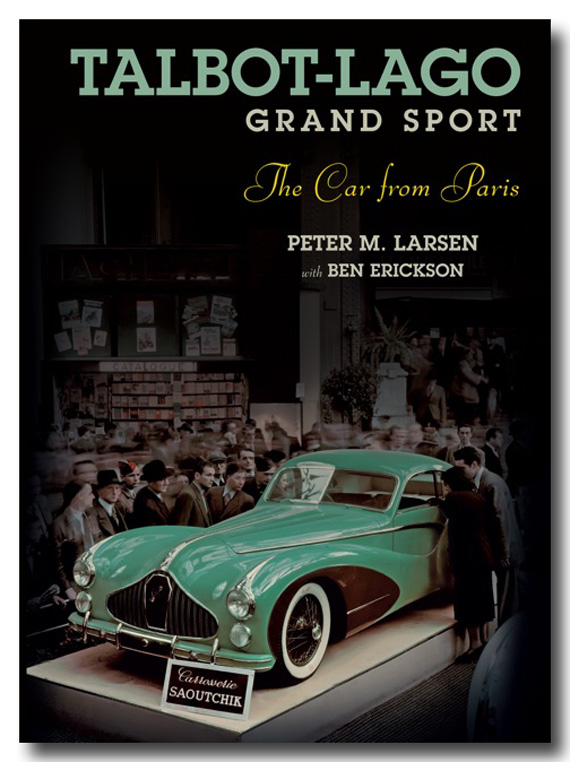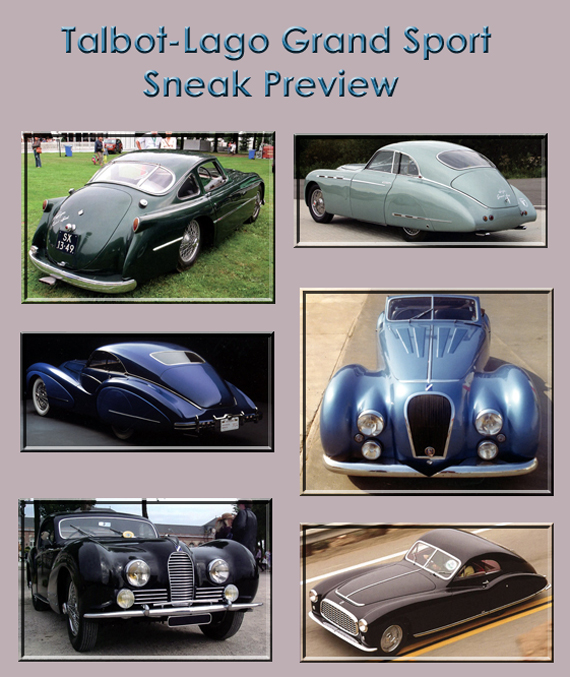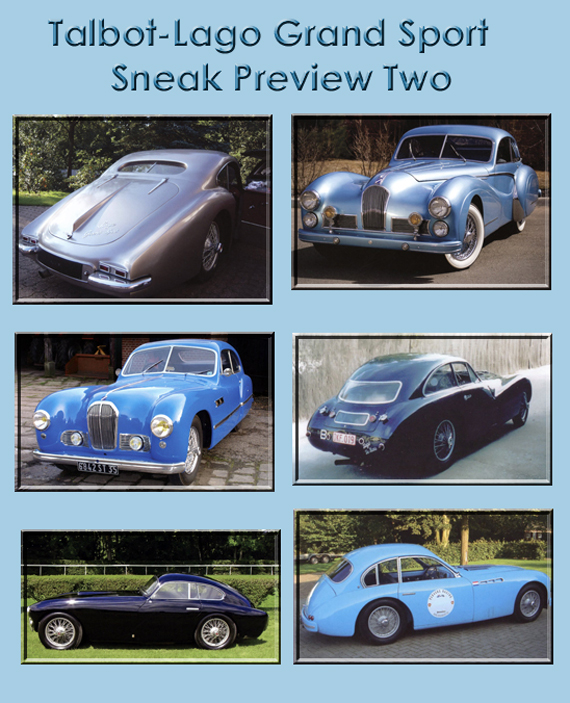Click here for details and to order from Dalton Watson
Reveiw by Pete Vack
The “Talbot-Lago Grand Sport” arrived in a very heavy box, and like a Russian matryoshka doll, this was opened to find a luxurious 14.5 x 9.5 x 3.5 inch carrying case with handle, profusely illustrated with the cover material printed in full color. That in turn opened to reveal an even more luxurious 13 x 9 x 3 inch slipcover, which in turn harbored a slick, high quality two-volume set of the “Talbot-Lago Grand Sport”. Standard volumes are $350, with a limited number (600) of copies. Leather bound editions are $650 and only 100 copies.
We are sure most of our readers are aware of this line of Talbot-Lago cars, called Grand Sports. They can be seen occasionally at auctions, major concours, in select museums, and at important retro events. But such sightings are rare, fleeting, scattered throughout time and space, never allowing one to grasp the meaning, numbers or depth of the species. Most knowledgeable enthusiasts could probably not put forth a useful definition of the Talbot-Lago Grand Sport, much less recite how many were built, coachbuilders, where they are today and what they look like. Even co-author Peter Larsen, in the introduction, had to explain that the book was specifically about the Talbot-Lago Grand Sport, a rare model which did not include the more famous pre-war Figoni et Falaschi teardrop coupes based on the T150SS chassis.
MYSTERY CARS
The amount of information available about the Talbot-Lago Grand Sport (TLGS) is truly meager and as scattered as the appearance of the cars themselves. The Grand Sport model was not acknowledged in the original Georgano Encyclopedia, completely overlooked in William Stobb’s “Les Grandes Routieres”, mentioned only briefly in an excellent article on the automobiles of Tony Lago in “Automobile Quarterly’s” V23 No 4. An Internet search will reveal images and videos of several of the cars, some good information from our friends at Coachbuild.com and some auction company information, but all scattered and incomplete. Wiki is notably short on the Grand Sport. The bibliography in the “Grand Sport” book lists six books – most in French – that pertain directly to Talbot-Lago, and that’s probably pushing it. In short, there is not much out there.
That’s precisely what makes the Peter Larsen/ Ben Erickson “The Talbot-Lago Grand Sport” so interesting, valuable, entertaining, informative, necessary, compelling, and a thrill to read. For the first time, the Talbot-Lago Grand Sports have been tracked down, gathered, defined, explained, photographed and detailed, chassis by chassis. It is overwhelmingly new and fresh information. Many of the cars have not been seen in years; a few are in private collections unknown even to the authors; some – though very few – have just disappeared, and most are now and have been kept in Europe.
WHAT IS A GRAND SPORT
The Grand Sports were Tony Lagos’ supercars, the top of a very expensive line. Based on the pre-war Grand Prix chassis (with a 2.65 meter wheelbase and later 2.80 meter) they were given coachwork by Figoni, Saoutchik, Dubos, Franay, Graber. The T26 was virtually the same 4.5 liter Marchetti-designed hemi-head used in the Grand Prix Talbots of the era, minus the aluminum block, dry sump oil system and with different carburation, most using 3 Zenith carbs. This resulted in the most powerful French road car built at the time, with at least 190 horsepower on tap. The Wilson preselector gearbox was the same unit as used in the race cars as well. The chassis consisted of massive steel girders, independent front suspension via transverse leaf spring, and a live rear axle under the frame located by leaf springs. It was archaic but light. A huge 120 liter fuel tank meant long periods without stops but little space left for luggage. In a very real sense, a road-going GP car. Larsen figures that from 1947 to about 1950, between 29 and 35 Grand Sports were built on both 2.65 and 2.80 meter wheelbases.
With coachwork more art than automotive, the Grand Sport, as the book’s PR would have it, was “chic, ritzy, aristocratic with a superb pedigree that gave it instant admission to the elite gatherings at races and concours, no questions asked”. The coachwork that graced the Grand Sport chassis ranges from the bizarre and odd, to beautiful and advanced, from lithe racing barchettas to svelte coupes. Each is unique, most are stunning.
LAGO RECORD VS GRAND SPORT
Allow us to digress for the benefit of our very astute readers who may wonder about the difference between the Grand Sport and the more common Lago Record: In the post-war era, the Talbot-Lago line consisted of the 6 cylinder T26 Record and Grand Sport, and the 4 cylinder Talbot-Lago “Baby”. The normal T26 Record used the same engine as the Grand Sport but produced 170 hp, using only two Zeniths. The Record chassis was much longer at 3.12 meters; the weight was 1280 Kg. As a post-war design, the Record feature coil spring independent front suspension. However, Lago’s goal for the Grand Sport model was to use whatever resources at hand to quickly create a lightweight high-performance chassis at low cost, hence the use of the pre-war GP chassis. It was 47 cm shorter and 430 Kg lighter than the new Lago Record. That the GP chassis made use of a transverse-spring front suspension was perhaps a necessary compromise. While it was seemingly a retrograde step, it made sense and Lago figured he could market it as a “perfected road car chassis, which has much of the power, road holding and strength of my Grand Prix racing machines.”
A NECESSARY OPUS
In the realm of French and Italian cars, we can only compare this new work to Christian Huet’s book on Gordini (in French only) and Simon Moore’s Alfa Romeo 2.9 and 2.3 volumes. In many respects, though it covers fewer individual chassis, the TLGS does it better, making use of more outstanding color photography as well as historical black and white images, complemented by outstanding layout and presentation. Like Moore and Huet, Larsen and Erickson are relentless detectives, tracing each car as far as possible from its birth to the present day. In most cases, where and whenever possible, the authors consult with the current owners and provide photos of the cars as they appear at time of publication. This with a considerable amount of historic images in both color and black and white, leaving little left to wonder.
Like Moore, they are not professional writers per say and at times the text can annoy. But any such annoyances are readily tossed aside as the full impact of the material presented simply blows one away. Perhaps unfairly, but in light of the overall magnificence, we care less if a rare word (“bespoke”) is over-used, or if certain peculiarities are repeated (on six different occasions calling Coatalen to task for spending too much on racing). Written off is a mistake attributing Rocco Motta as the coachbuilder for the Renault/Marquis (read story). Tony Lago was perhaps a bit less than the authors admit. More information about the post-war Talbot line and less about the Pons plan would have been nice. This ain’t Shakespeare, but it is a breathtaking revelation of the most hidden, most outlandish, most artistic, and often the most beautiful cars on earth.
VOLUME 1
While Moore dealt with a very well-known subject matter, the team of Larsen/Erickson knew that they would have to set the scene for the actual serial number saga. Volume 1 includes a fairly in depth history of the S-T-D year but focuses on the story of Tony Lago, his triumphs and repeated problems trying to keep his firm alive and solvent while he upheld the honor of France on the race tracks and the Paris salons. The authors have done their research here, bringing in new facts about the life and death of Talbot, the heartbreaking bankruptcies, the mistakes and the competition, but alas, no one yet knows much about the private life of Tony Lago.
Technically, there is a chapter on the history and workings of the Wilson pre-selector gearbox, the chassis, and yet another about engines that would power the fabled Grand Sports. They are not in great depth, but enough to garner a good understanding of the components. The chapter on the Wilson gearbox was most welcome.
Much to our delight, Volume 1 also contains fairly substantial histories of the coachbuilders that clothed the Grand Sports. How much do you know about Dubos, Antem, Besset, Pennock, and Contamin? Altogether the authors found eighteen different coachbuilders and/or designers responsible for the Grand Sport bodies. Each one is given a chapter. Only Farina, Saoutchik, Graber and Motto were familiar to this reviewer in any depth.
Alas, nowhere in Volume 1 is there good photos of any of the 35 plus cars that are described in Volume 2! The authors wanted to save the subject shots for the second volume. At first this was rather annoying, as there were plenty of references to the Grand Sport series. Then I (egad, pardon my first person here!) decided to go with the flow. I carefully digested Volume 1’s 238 pages, while absolutely refusing to even open the cover of the larger, heavier 407 page Volume 2, which I knew consisted of all the chassis numbers. Something told me I’d be into something good.
THE TREASURES IN VOLUME 2
Admittedly, not jumping into Volume 2 takes some self-discipline, but it was worth it. For every night I would discover a new and interesting if not bizarre car which I had never before or rarely seen. Or seen only in grainy Road & Track photographs, or in photos take in the poor light of museums or obstructed by asses and elbows of the concours field. But here they all were in both color and historic images, almost large that life, with details and histories. Each chapter was to be saved and savored, each one a treasure, even to one who is admittedly pretty jaded in terms of automobilia by now.
This leads to a problem; one can be devastated when the last of the 648 pages are turned, the last car unveiled, the last morsel tasted.
This is a huge book, an important book, and a superb effort, well worth the money. The price of entry is mitigated by the high probability that it is an investment which will grow in value.
In the next few weeks, we’ll give you further insights and previews of a few of the Talbot-Lago Grand Sports. Yeah, you too, can wait!


